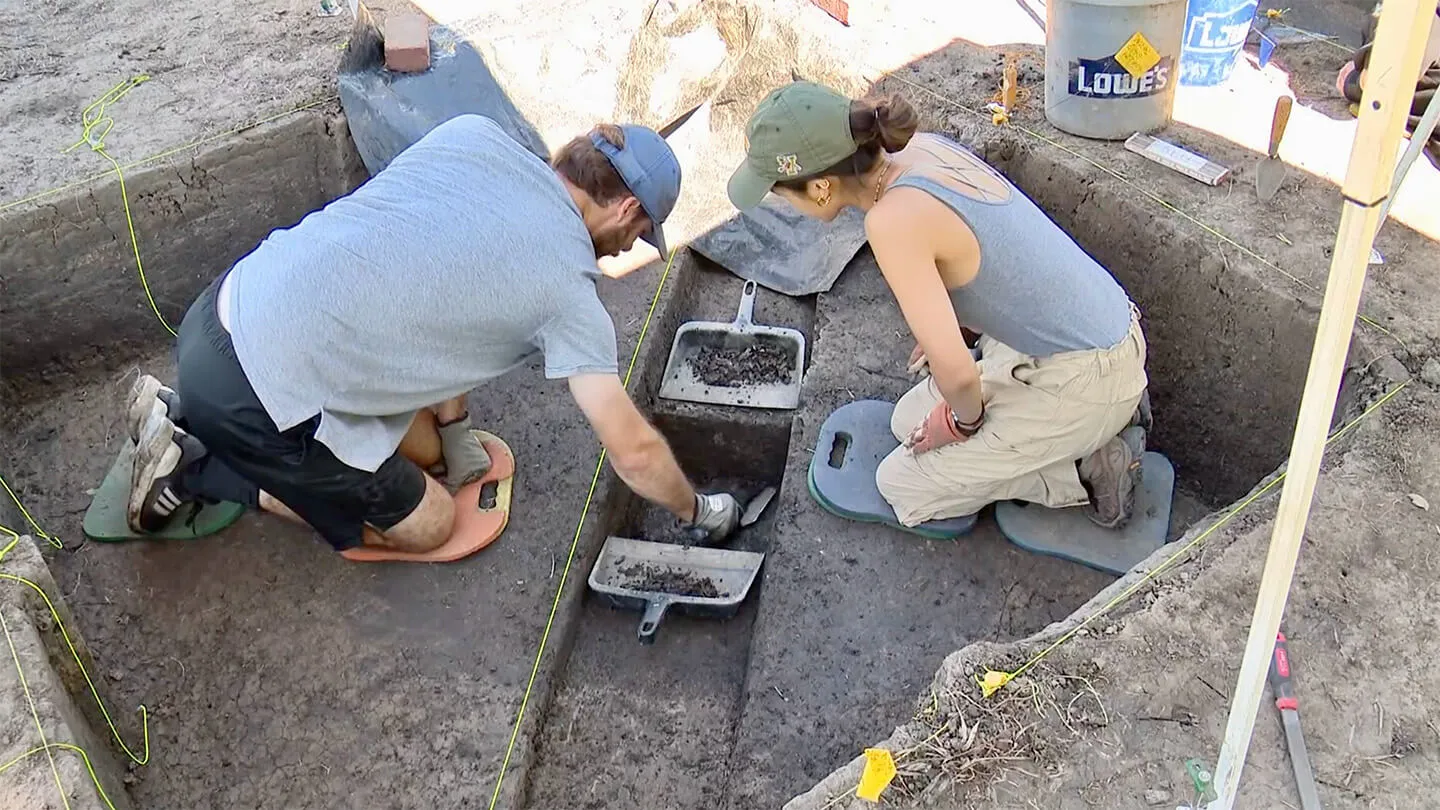In UVM’s College of Arts and Sciences, student research is a cornerstone of the liberal arts experience. Students are encouraged to build their critical thinking skills by asking deep questions about topics they’re passionate about, leading to discoveries and improvements in areas as old as prehistoric soil impressions and as new as AI. You’ll find these student scientists in labs, certainly, but also in art studios, libraries, classrooms, natural areas, community spaces, dorm rooms, and coffee shops. But no matter where they are or what they’re working on, they have one key thing in common: They’re broadening their view—and ours—of the world and our place in it. But don't just take our word for it. Listen to these 10 CAS students as they share thoughts on their unique research journeys and where those paths might lead them.
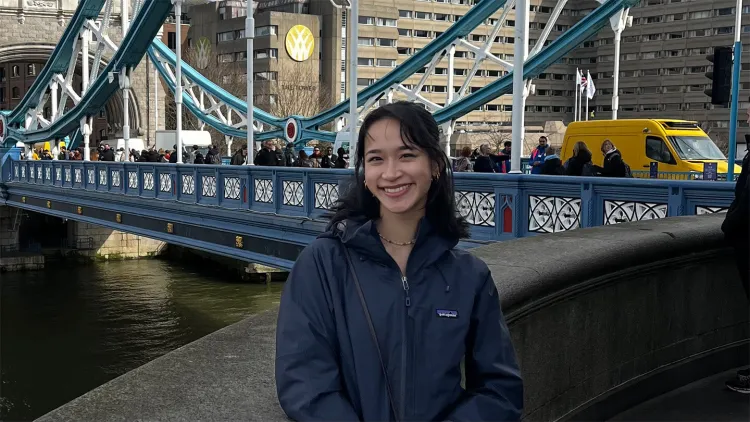
Name: Hal Nalamliang (seen in both photos above)
Year: Senior
Major/minor: Anthropology major with a concentration in archaeology and heritage management, statistics minor
Research overview: “Over the past three semesters, my research has involved looking at post mold diameters to analyze wood usage at Cahokia, the largest prehistoric settlement in North America. Post molds, which are found through archaeological excavation, are the negative impressions in soil where wooden posts once stood upright. They can tell us a lot about the shape, size, and function of wooden structures, orientation of villages, and preferred sizes or growths of wood. There has been a long-standing hypothesis that the inhabitants of Cahokia overexploited wood resources in the American Bottom by clearing already sparse forest zones. This hypothesis suggests the clearing of trees decreased the stability of the landscape, increasing flooding and risks to crops, and eventually leading to the depopulation of Cahokia. By analyzing the trends and patterns of post molds, my research aims to give us a better understanding of Cahokia’s wood usage. Learning about these trends in wood use is important because it can help change our thinking surrounding this narrative that wood was overexploited.”
What has surprised them: “The most surprising aspect of my research has been learning how archaeology can be applied to the broader context of environmental activism. When I started this project, it was mainly for the sake of doing research on a topic that interested me, but as I’ve learned more about wood usage in this prehistoric context, I’ve also gained a better understanding of the applicability of my field. My research has shown me how learning about the past peoples and their environments can help us challenge issues related to climate change and influence our interactions with our own environment.”
What they’ve gained: “I really enjoy research, and by taking on this project, I feel like I’ve been given the opportunity to improve my research and writing skills beyond what you’d typically learn in a college classroom. Working closely with my thesis advisor, Dr. Marieka Brouwer Burg, has also inspired me to continue learning every day and pursue graduate school for archaeology. In the long term, I’d like to use this research experience to inspire others to be passionate about learning and find their love for anthropology and archaeology, like the faculty of the anthropology department have done for me.”
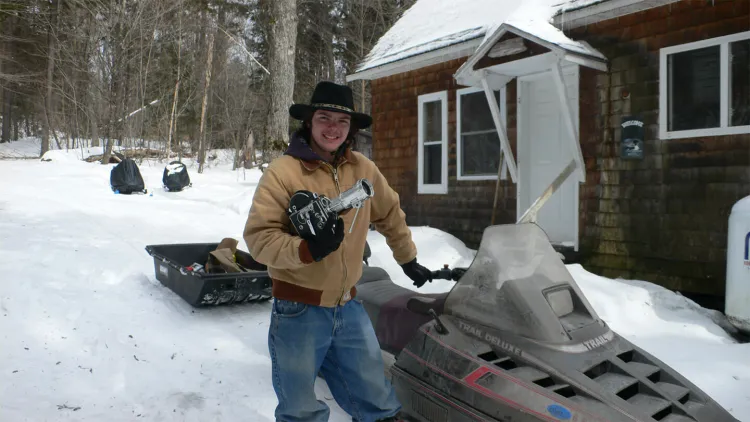
Name: Brendan Hollis
Year: Senior
Major/minors: Film and television studies major, wildlife biology and reporting and documentary storytelling minors
Research overview: “I am exploring the history of film through the practice of shooting analog Super8 and 16mm. This process has forced me to slow down and focus on both the technology and aesthetics of the medium. Professor Deb Ellis and I have been restoring the University’s vintage film projectors and editing equipment, and experimenting with using them in the digital age. Currently, I am using an analog film editing machine known as a Steenbeck to edit. With physical film, you must cut each clip by hand and join them together again. The Steenbeck allows an editor to view multiple sound and video tracks together and sync them onto one reel. We also plan to create a soundtrack on magnetic tape that can be played simultaneously with the video. Right now, we are experimenting with an older magnetic sound recorder that uses 16mm audio tape that can then be edited with the 16mm film. The goal of this project is to have a greater understanding of and appreciation for how films were once made, and to create a physical film that can be shown using a 16mm projector.”
What has surprised him: “The process of editing by hand has been the most surprising aspect of this work. Compared to digital editing, this method is much more involved. Each cut must be strategically thought out because there is no undo button. This research has shown me the importance of planning out a film from beginning to end while also highlighting new ways in which one can experiment with the film form. With each cut, the film begins to take shape and it’s quite exciting seeing the film you shot come to life.”
What he hopes to gain: “I hope to get a better understanding of what it means to be a filmmaker. The process of shooting film has taught me a lot about the importance of each shot. Every time you record, the camera must be set up perfectly due to the mechanical nature of these analog devices. Editing by hand has also taught me the importance of the flow and organization that an editor must maintain. I hope I can continue to learn more about the history of filmmaking through the physical practices of editing with a Steenbeck and shooting on film. This exploration has given me a valuable insight into the history of cinema while providing me with new ideas for future experimentation.”
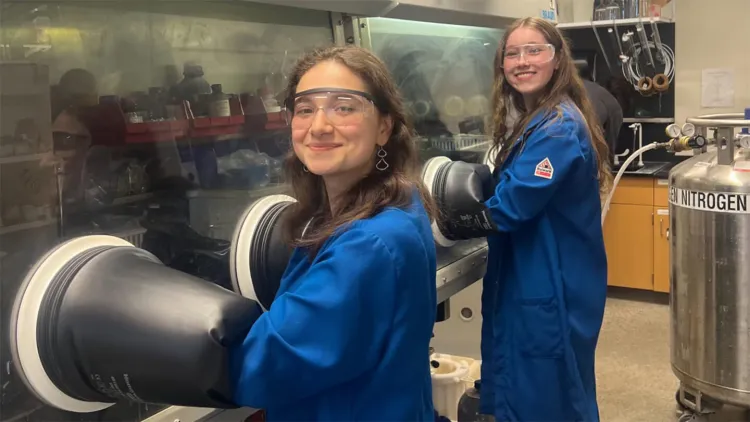
Name: Nory Meinhart (above left) and Evelyn Kempf
Year: Senior (Meinhart); junior (Kempf)
Majors/minors: Chemistry major, art history minor (Meinhart); math major, chemistry minor (Evelyn)
Research overview: “We are working on a project that focuses on adding phosphorus to alkenes (a type of chemical compound) in a process called catalytic hydrophosphination. We are developing ways to create phosphorus-containing products that are useful in medicine, farming, and electronics. Specifically, we are working to make this process more sustainable by avoiding the use of metals, instead using either a cheap salt or ethanol (a green solvent). We are also investigating how light affects hydrophosphination reactions and figuring out how to use a wider variety of alkenes in this process. By using different alkenes and phosphine substrates, we have found that our methods work in many situations, and we have been able to create many new compounds and understand their reactions better.
These hydrophosphination products are useful for making organometallic iron compounds. We have successfully created several iron salts that could be used in catalysis (speeding up chemical reactions) and drug development. Our work with iron started in the summer of 2024 when we co-led a research group under the Army Educational Outreach Program. This program gave high school students from underrepresented backgrounds the opportunity to engage in the R1 research experience and help make and study these iron salts.”
What has surprised them: “What has emerged as most interesting is the interconnection of our initially separate projects as we continue to discover all the ways that different questions between a variety of labs, departments, and communities come together. The collaborative and outreach-based aspects of our projects have been not only prominent, helpful, and accelerating, but they have also brought our work outside the lab. It is inspiring to see where our work applies to real-world scientific and industrial tasks, and even more so to see how the process itself can bring so many people together around scientific methods.”
What they’ve gained: “Our work lends itself very directly to our professional development in that it has given us a wide variety of technical and communication skills, as well as familiarity with both the scientific process and the management of projects and teaching situations. Along with the chemically specific experience we’ve gained here, the lab has been a great place of community building. The most valuable takeaway from our time here is the knowledge that the social and professional network we’re building will outlive our time at UVM. We hope to continue to strengthen these community aspects of our work and bring those ties to all the younger department members who will follow.”
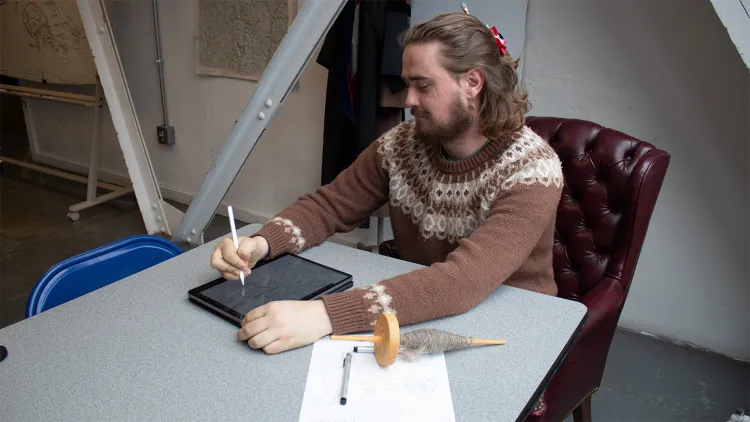
Name: Matt Pickarski
Year: Senior
Major: Anthropology
Research overview: “In short, I am producing an imaginative reconstruction of the Bronze Age world using the epic of the Odyssey as a cultural lens through which to peer into the past. Last year, Professor Luis Vivanco began teaching me how to express research through the medium of comics, allowing more abstract or visually significant aspects of research to shine through in a way that is more engaging. Archaeological evidence and ancient Greek scholars place the Odyssey as occurring sometime during the Late Bronze Age (around 1200 BC), a time when a lavish, militaristic, heavily organized society known as the Mycenaeans occupied what is now known as mainland Greece. With complex economic and writing systems, colorful clothing and art, and incredible architecture, this period was artistically and culturally spectacular—and comics are the perfect medium to acknowledge the artistry of the period.”
What has surprised him: “During my research, I found some discrepancy between how the Homeric Epic describes women’s roles in textile production and what actually occurred during the Bronze Age. Homeric Epic tells a tale of skill, where slaves and queens alike could earn respect for skills honed before their own looms. Helen, Penelope, and Andromache are all described as avid weavers, with Penelope even using her loom to display her intelligence and cunning as she “spins” lies to keep the suitors invading her home at bay. However, the realities of Mycenaean textiles tell a much darker story, where women, often enslaved, were reduced to their production goals and allotted food rations as they produced fineries to be worn by elites. This sharp contrast surprised me, as I was sure there would have been some continuity between Homeric Epic and archaeological realities.”
What he’s gained: “This process has been a labor of love. I am not only conducting research, but I am also illustrating dozens of pages of Mycenaean architecture and characters from the Odyssey in accurate clothes, hairstyles, etc. While an ambitious project, it has been really rewarding as well. My art has improved significantly during this process, and my research skills have benefited too. I hope that after this is completed, I will be able to enter other opportunities in the realm of archaeological illustration and comics-based research. I also hope my work allows people to see the world of Homeric Epic from a new perspective, putting archaeological details in spaces and people that have been much more generalized in previous interpretations.”
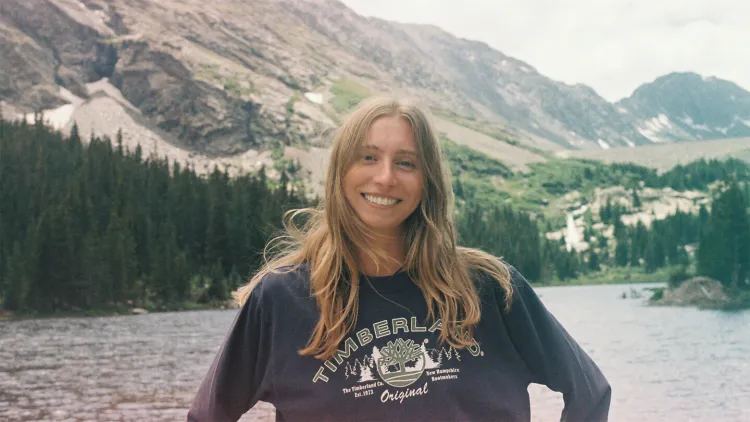
Name: Grace Elston
Year: Senior
Major/minor: History major, Holocaust studies minor
Research overview: “For my honors thesis, I am studying female Jewish inmate physicians who worked in the Auschwitz-Birkenau camp complex. From the available post-war testimony and memoir literature, I have selected six case studies from women of diverse backgrounds who worked in various hospitals, infirmaries, and experimental blocks throughout the camp complex. Working in unclean, unsterile, dismal conditions, with few supplies, Jewish inmate doctors were responsible for caring for thousands of Jewish prisoners. Female Jewish inmate doctors were given the impossible task of healing in the shadow of the gas chamber. Currently, there is no single comprehensive work on female Jewish prisoner physicians. My thesis offers a look inside the gendered experience of women in the camp in Auschwitz-Birkenau
What has surprised her: “When I first began searching for a thesis topic, I was surprised to find out that there was a significant body of work dedicated to Jewish prisoner physicians in Auschwitz, along with a rich pool of memoirs and testimonies to draw from. It was even more surprising to find out that, given these resources, there was no comprehensive work on female Jewish prisoner doctors in Auschwitz. In the early stages of my research, I was further surprised to see how often certain female inmate physicians were given fleeting mention in larger works as witnesses to daily camp life, acknowledging the importance of their testimonies in a broader understanding of Auschwitz, while always treating them as auxiliary characters. Thus, I was excited to embrace the challenge of finally giving a voice to the female Jewish prisoner physicians whose situation in the Auschwitz-Birkenau camp complex has yet to be fully understood.”
What she’s gained: “Through my writing, I hope to pave the way to more comprehensive research on these Jewish medical women, both in Auschwitz and beyond, while also bringing their voices to a wider audience outside of academia. On a more personal level, this experience is allowing me to continue practicing and honing my skills in archival research, primary source analysis, and long-form academic writing, all of which will better prepare me to continue my education in history and Holocaust studies at the graduate level. Furthermore, upon my graduation from UVM, I plan to continue and expand upon my thesis research beyond Auschwitz as I undertake a Ph.D. in history at Indiana University, thereby helping to broaden the historiography of female Jewish inmate physicians in other Nazi concentration camps.”
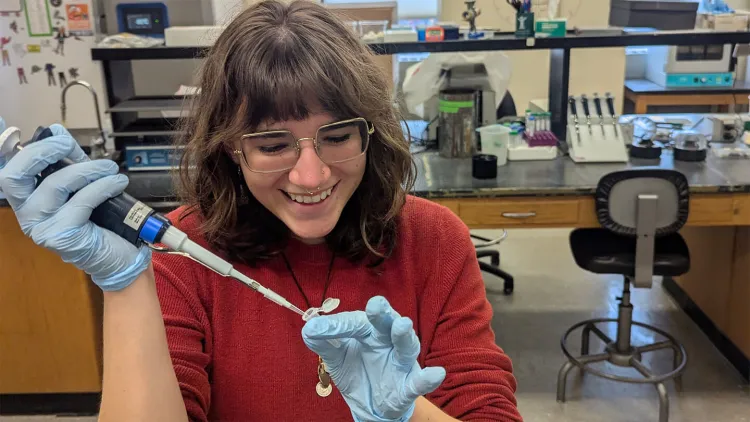
Name: Lila Tomlinson
Year: Senior
Major: Neuroscience
Research overview: “My honors thesis research involves the investigation of the DCBLD2 orphan receptor and its role in visual system development and function. I’ve been doing my research in the Ebert lab using zebrafish as a model organism. I built my project upon preliminary data from the lab, where a mutant phenotype of DCBLD2 resulted in photo receptors spilling out of the eye via the optic nerve eight days post-fertilization. I’ve been working to discover the exact timing of the phenotype and to learn how this spillage might impact the fish’s ability to see. Since our lab mainly uses histological investigation (looking at tissues and cells under a microscope) and doesn’t have a mechanism to measure visual acuity, I designed, constructed, and tested an optokinetic response chamber that allows one to take such measurements of zebrafish by observing their limit to tracking rotating stripes. I was able to do this thanks to a summer undergraduate research fellowship through the UVM FOUR office. I am very grateful for the opportunities that my fellowship and my work in the Ebert Lab have provided.”
What has surprised her: “I was curious to see how I would feel about working in a lab full-time with my fellowship and was pleasantly surprised to discover I love it. Sometimes experiments can feel mundane, or something goes wrong and you can’t figure out why, and that can be frustrating, but it’s all a part of a scientific puzzle. I just love coming into the lab and never quite knowing what results I will get and where they will take me.”
What she’s gained: “My research has provided me with the opportunity to apply what I am learning in class to a research setting, and this has been invaluable to my understanding of biological techniques and their applications. It’s given me confidence in myself and my studies, and I am excited to take what I have learned and use it as a foundation for future research opportunities. I am planning to become a research technician prior to graduate school and am confident that my experience and education at UVM have prepared me for the next steps in my career.”
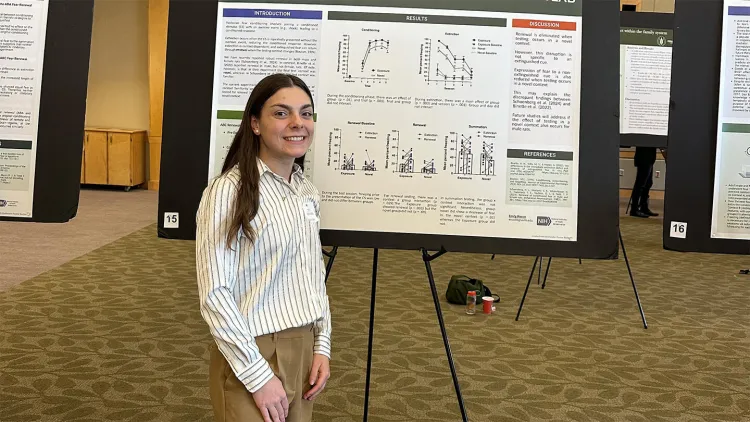
Name: Emily Rocco
Year: Senior
Major/minor: Psychological science major, neuroscience minor
Research overview: “I am investigating fear renewal in rats, a phenomenon where a previously extinguished fear response (when an animal stops showing fear to a stimulus) re-emerges. Previous studies conducted in our lab have found no significant sex differences in fear renewal. However, research from another lab showed that male rats exhibit greater fear renewal under similar conditions. A key difference between our labs is that we make sure the rats are equally familiar with the contexts used in our experiments, while the other lab tests their rats in a completely new context. To explore how this difference might affect the results, I conducted an experiment that changed how familiar the rats were with the context. The findings showed that rats exposed to a familiar context before the test showed a clear renewal effect, demonstrated by a significant increase in freezing behavior. In contrast, rats tested in a new context did not show fear renewal. If similar mechanisms are at play in humans, interventions designed to change environmental cues or how familiar someone is with their surroundings might help reduce fear renewal and lessen post-traumatic stress disorder (PTSD) symptoms, especially in people who have experienced trauma in familiar settings.
What has surprised her: “What surprises me most is how closely my research ties into what I’m learning in my classes. The impact of context familiarity and novelty on fear responses was an unexpected discovery, and it has made me realize just how directly it relates to the concepts discussed in my neuroscience and clinical courses, especially regarding how PTSD symptoms are often triggered by familiar environmental cues. Seeing this connection has deepened my understanding of how the brain processes fear and how context can influence the reactivation of traumatic memories.”
What she hopes to gain: “Through this research, I hope to achieve both personal and professional growth. Personally, I’m working to deepen my understanding of the experimental process and refine my skills in designing and conducting studies. I plan to run more experiments in the lab that are directly related to my master’s thesis next year, allowing me to build on the foundation I’ve established so far. Professionally, I aspire to become the best lab member I can be—supporting my colleagues in the Todd Lab and contributing to the team in meaningful ways, just as they have always supported me.”
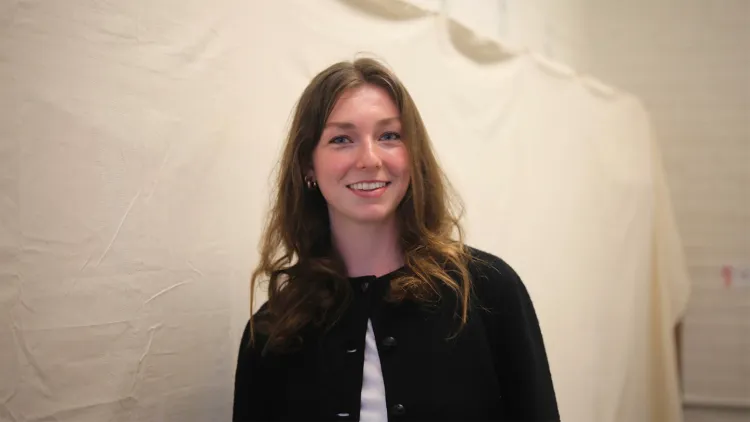
Name: Grace Garavan
Year: Senior
Majors/minor: Anthropology and political science major, global studies minor
Research overview: “Motivated by the intersection between technology and the environment, I’ve spent the last year exploring the use of AI in identifying environmental trends, with an emphasis on climate change phenomena. Assisting Jenn Karson, founder of the Plant Machine Design Group at UVM, I photographed an original dataset of over 10,000 leaves that were eaten by an invasive species, Lymantria dispar (spongy moth caterpillar), during the outbreaks of 2021 and 2022. This Damaged Leaf Dataset was used to train a Generative Adversarial Network (GAN) to visualize patterns of damage and simulate the regeneration of this iconic Vermont foliage. Each leaf was collected, cleaned, pressed, then photographed and cataloged through this process. The AI algorithm can speculate on what the leaf looked like before it was eaten by the spongy moth caterpillar, or what a whole leaf would look like if the caterpillars ate it. We ‘ve presented this research to the public through gallery exhibitions and an interactive interface demonstrating how the AI algorithm processed each leaf and ‘healed’ the damage through layers of data.”
What has excited her: “I’ve been really excited about the idea of using technology to repair, rather than damage, our relationship with nature. By focusing on an invasive species in New England affected by the regional impacts of climate change, we hoped to showcase how AI can ‘solve’ pressing environmental issues while also being mindful of the environmental toll that such computing requires. The framework of phytomechatronics, which fascinates me, is about imagining technological advancements that nourish rather than extract from biological systems—a difficult balance to strike.”
What she’s gained: “Through my involvement in this project, I have gained both an immense appreciation for the patience required in experimental research and a love for arts-based methodologies. Photographing over 10,000 leaves took months, but I believe there was value in being able to see each piece of data individually, and conveying this data to the public through both artistic and scientific representations allowed people to interact and connect with it more. I plan to attend a master’s program in anthropology after I graduate, and I believe my appreciation for both the research process and the creativity in communicating its result will serve me well.”
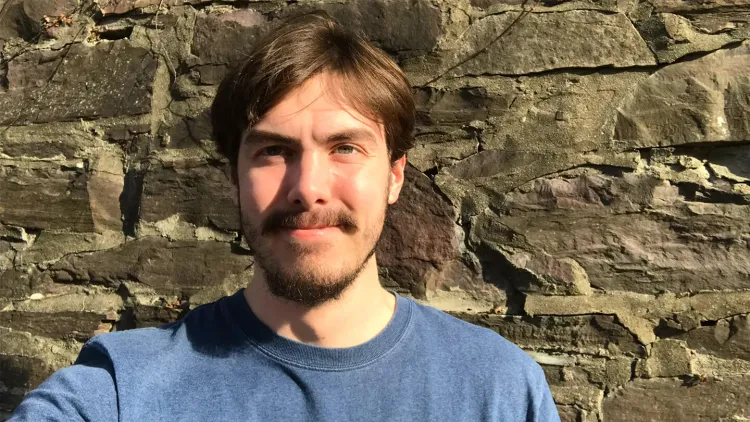
Name: Luke Pulaski
Year: Senior
Major/minor: Economics major, Spanish minor
Research overview: “I have been studying the effects of immigration on the housing market over the past decade. I research census data on new migration into the United States and look at how it affects rental rates and housing prices in 400 of the largest cities in the United States during that period. So far, I’ve seen somewhat of a positive correlation between changes in immigrant concentration and the housing market. Many immigrants choose to come to a certain city because there are already a lot of others there from their country, and once we account for that, we find that the effect of immigration on rental and house prices increases even more. But then there is another dimension to consider. Immigration isn’t the only thing that drive population growth—you also have to account for the mobility of the native population. Once you factor that in, the direct effects of immigration on housing costs are actually quite minimal. From my research, I’ve concluded that immigrants and native-born individuals are complementary to one another, which is contrary to what you hear in political discourse about immigration policy, where immigrants are seen as competing for resources.”
What has surprised him: “What has surprised me the most is the induced demand effect, which is basically the effect immigration has on native population growth or movement and the resulting effect on the housing market. I did not expect there was going to be such a large induced demand effect when I first started this. Like I said, it goes against what you hear on the news about immigration policy.”
What he’s gained: “The main goal of this paper is to get more research experience, but there’s the added benefit that it will also make a good writing sample. That will be helpful at some point in the future if I go back to school for a master’s degree. Also, this paper has really helped improve my econometric and research skills. I've had the opportunity to learn—and get great feedback on this project— from my professors. They’ve taught me how to interpret research papers from my literature review, how to better tell a story with data, and how to better explain and connect my results. I’m very grateful to them.”
